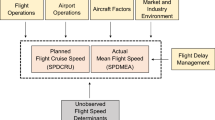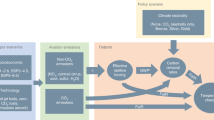Abstract
The airline industry closely monitors the midlatitude jet stream for short-term planning of flight paths and arrival times. In addition to passenger safety and on-time metrics, this is due to the acute sensitivity of airline profits to fuel cost. US carriers spent US$47 billion on jet fuel in 2011, compared with a total industry operating revenue of US$192 billion. Beyond the timescale of synoptic weather, the El Niño/Southern Oscillation (ENSO), Arctic Oscillation (AO) and other modes of variability modulate the strength and position of the Aleutian low and Pacific high on interannual timescales, which influence the tendency of the exit region of the midlatitude Pacific jet stream to extend, retract and meander poleward and equatorward1,2,3. The impact of global aviation on climate change has been studied for decades owing to the radiative forcing of emitted greenhouse gases, contrails and other effects4,5. The impact of climate variability on air travel, however, has only recently come into focus, primarily in terms of turbulence6,7. Shifting attention to flight durations, here we show that 88% of the interannual variance in domestic flight times between Hawaii and the continental US is explained by a linear combination of ENSO and the AO. Further, we extend our analysis to CMIP5 model projections to explore potential feedbacks between anthropogenic climate change and air travel.
This is a preview of subscription content, access via your institution
Access options
Subscribe to this journal
Receive 12 print issues and online access
$209.00 per year
only $17.42 per issue
Buy this article
- Purchase on Springer Link
- Instant access to full article PDF
Prices may be subject to local taxes which are calculated during checkout





Similar content being viewed by others
References
Horel, J. D. & Wallace, J. M. Planetary-scale atmospheric phenomena associated with the southern oscillation. Mon. Weath. Rev. 109, 813–829 (1981).
Seager, R., Harnik, N., Kushnir, Y., Robinson, W. & Miller, J. Mechanisms of hemispherically symmetric climate variability. J. Clim. 16, 2960–2978 (2003).
Thompson, D. W. J. & Wallace, J. M. Annular modes in the extratropical circulation. Part I: Month-to-month variability. J. Clim. 13, 1000–1016 (2000).
Solomon, S. et al. (eds) Climate Change 2007: The Physical Science Basis (IPCC, Cambridge Univ. Press, 2007).
Burkhardt, U. & Karcher, B. Global radiative forcing from contrail cirrus. Nature Clim. Change 1, 54–58 (2011).
Williams, P. D. & Joshi, M. M. Intensification of winter transatlantic aviation turbulence in response to climate change. Nature Clim. Change 3, 644–648 (2013).
Wolff, J. K. & Sharman, R. D. Climatology of upper-level turbulence over the contiguous United States. J. Appl. Meteorol. Clim. 47, 2198–2214 (2008).
Kalnay, E. et al. The NCEP/NCAR 40-year reanalysis project. Bull. Am. Meteorol. Soc. 77, 437–471 (1996).
Jaffe, S. C., Martin, J. E., Vimont, D. J. & Lorenz, D. J. A synoptic climatology of episodic, subseasonal retractions of the Pacific jet. J. Clim. 24, 2846–2860 (2011).
Taylor, K. E., Stouffer, R. J. & Meehl, G. A. An overview of Cmip5 and the experiment design. Bull. Am. Meteorol. Soc. 93, 485–498 (2012).
Delcambre, S. C., Lorenz, D. J., Vimont, D. J. & Martin, J. E. Diagnosing northern hemisphere jet portrayal in 17 CMIP3 global climate models: Twenty-first-century projections. J. Clim. 26, 4930–4946 (2013).
Delcambre, S. C., Lorenz, D. J., Vimont, D. J. & Martin, J. E. Diagnosing northern hemisphere jet portrayal in 17 CMIP3 global climate models: Twentieth-century intermodel variability. J. Clim. 26, 4910–4929 (2013).
Barnes, E. A. & Polvani, L. Response of the midlatitude jets, and of their variability, to increased greenhouse gases in the CMIP5 models. J. Clim. 26, 7117–7135 (2013).
Acknowledgements
The authors thank B. Carmichael and B. Sharman of the National Center for Atmospheric Research Aviation Applications Program, G. Compo of the Cooperative Institute for Research in the Environmental Sciences, and D. Battisti of the University of Washington Department of Atmospheric Sciences for helpful discussions. We acknowledge the World Climate Research Programme’s Working Group on Coupled Modelling, which is responsible for CMIP5, and we thank the climate modelling groups for producing and making available their model output. For CMIP5, the US Department of Energy’s Program for Climate Model Diagnosis and Intercomparison provides coordinating support and led development of software infrastructure in partnership with the Global Organization for Earth System Science Portals. CMIP5 model output data were acquired from the WHOI CMIP5 Community Storage Server, Woods Hole Oceanographic Institution, Woods Hole, Massachusetts, USA. NCEP/NCAR Reanalysis data were provided by the NOAA/OAR/ESRL PSD, Boulder, Colorado, USA, and acquired from their website at http://www.esrl.noaa.gov/psd. Domestic flight data were acquired from the TranStats website, maintained by the Bureau of Transportation Statistics, Research and Innovative Technology Administration (RITA), US Department of Transportation (http://www.transtats.bts.gov). Airline industry and business statistics were gathered from the MIT Global Airline Industry Program, Airline Data Project (http://web.mit.edu/airlinedata/www/Revenue&Related.html), Air Transport Action Group (http://aviationbenefits.org/media/26786/ATAG__AviationBenefits2014_FULL_LowRes.pdf), and National Air Traffic Controllers Association (NATCA). Emissions coefficients were gathered from the US Energy Information Administration (http://eia.gov/environment/emissions/co2_vol_mass.cfm). K.B.K. acknowledges support from the Strategic Environmental Research and Development Program, the WHOI Oceans and Climate Change Institute, the Alfred P. Sloan Foundation, and Microsoft Research.
Author information
Authors and Affiliations
Contributions
K.B.K. and H.C.B. jointly conceived the study. K.B.K. conducted the analyses and wrote the paper with input from all authors.
Corresponding author
Ethics declarations
Competing interests
The authors declare no competing financial interests.
Supplementary information
Rights and permissions
About this article
Cite this article
Karnauskas, K., Donnelly, J., Barkley, H. et al. Coupling between air travel and climate. Nature Clim Change 5, 1068–1073 (2015). https://doi.org/10.1038/nclimate2715
Received:
Accepted:
Published:
Issue Date:
DOI: https://doi.org/10.1038/nclimate2715
This article is cited by
-
Decreased takeoff performance of aircraft due to climate change
Climatic Change (2018)
-
Increased light, moderate, and severe clear-air turbulence in response to climate change
Advances in Atmospheric Sciences (2017)
-
Climate change in Lagos state, Nigeria: what really changed?
Environmental Monitoring and Assessment (2016)



